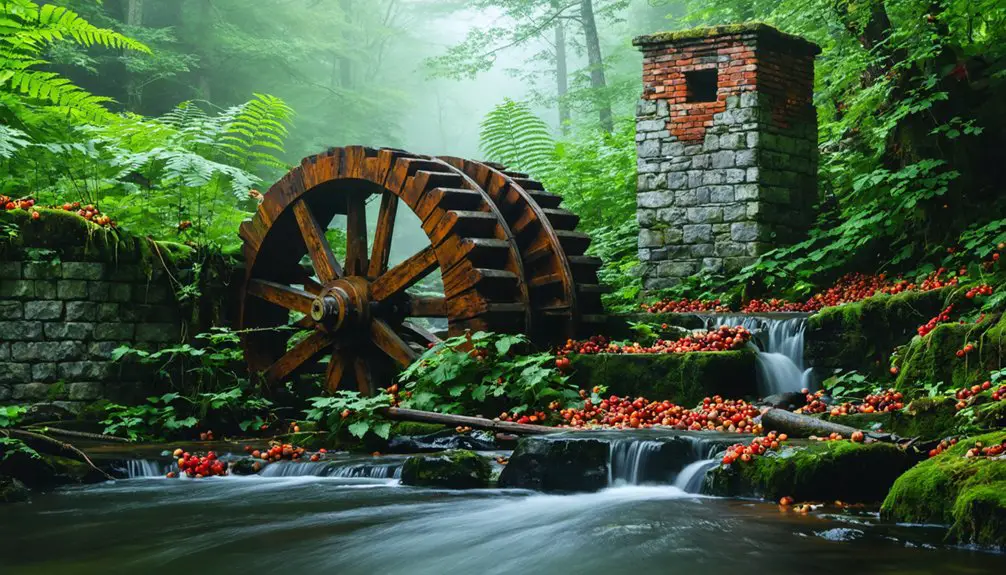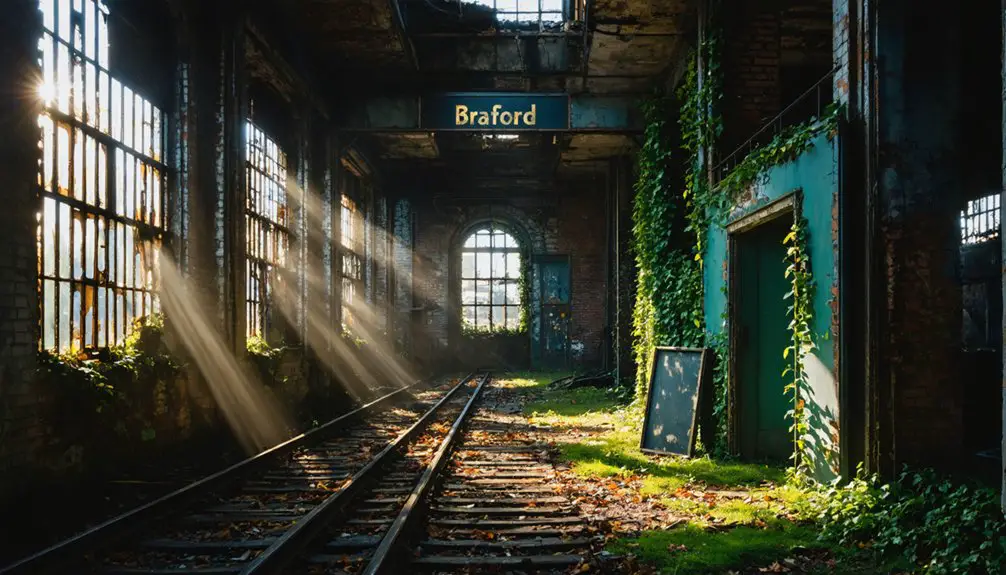You’ll find Fields Station’s stone remnants tucked away in Smithfield’s woodland, accessible via the Hanton City Trail off W. Reservoir Road. This former Quaker settlement, established in the early 1700s, thrived as a community of skilled craftsmen before its mysterious abandonment in the 1800s. Today, you can explore the ghost town’s weathered foundations, deep cellar holes, and historic stone walls. The site’s rich history holds fascinating secrets beneath its mature forest canopy.
Key Takeaways
- Fields Station, a Smithfield ghost town established in the 1700s, features historic stone foundations, cellars, and walls in Rhode Island woodlands.
- The settlement was founded by the Paines, Hantons, and Shippees families, with strong Quaker influences beginning in 1707.
- Access to Fields Station is via W. Reservoir Road in Smithfield, leading to a 3/4-mile hiking trail through woodland.
- The town was abandoned in the early 1800s due to economic changes and shifting railroad routes.
- The site contains well-preserved architectural remains, including deep stone cellars, well foundations, and intricate networks of stone walls.
The Origins of Hanton City
While mystery surrounds the exact founding of Hanton City, historical evidence points to its establishment in the late 1600s to early 1700s by three English families – the Paines, Hantons, and Shippees.
Local historians suggest these families may have received the land as a reward for their service during King Philip’s War. Another theory suggests the settlement emerged as a Loyalist Exile community during the American Revolution.
You’ll find that Hanton City developed into a close-knit community of skilled craftsmen by the 1730s.
The settlers made their living through Artisan Crafts, including tanning and bootmaking, while maintaining small farms. Their isolation from Smithfield’s town center allowed them to preserve their way of life until economic changes in the 1800s led to the settlement’s decline. The area included an important quarry that supplied stone to Providence buildings. Today, visitors can still see the remnants of stone walls that once marked the boundaries of this historic settlement.
Early Quaker Settlement and Community Life
The Quaker influence on Fields Station began in 1707 when Providence proprietors granted land titles to early Friends settlers in northern Rhode Island.
These pioneering families established a tight-knit Quaker community, building their meetinghouse along Great Road by 1721. You’ll find that their settlements reflected core values of simplicity and communal living, with timber-framed houses featuring distinctive stone chimneys dotting the landscape. The community emphasized mutual aid and support, helping members with everything from barn-raising to caring for the sick.
The meetinghouse served as both a spiritual center and social hub, where you’d have witnessed regular gatherings for worship and community governance. Like the historic Stony Brook Meeting House in New Jersey, these religious sites became focal points for early Quaker settlements.
The spiritual and social heart of Fields Station, where Quakers gathered to worship and make decisions for their community.
Though early settlement was initially slowed by conflicts with Native Americans, particularly during King Philip’s War, the Quaker community flourished under Rhode Island’s religious tolerance.
Families intentionally settled near one another, creating an interconnected network of farms and homesteads that supported their communal way of life.
Geographic Location and Layout
You’ll find the stone ruins of Fields Station nestled deep in Smithfield’s dense woodland, accessible via the Hanton City Trail that begins at 70 W. Reservoir Road.
The site’s rocky terrain reveals remnants of colonial life through its stone foundations, cellar steps, and a defunct dam system that once served the farming community.
While thick vegetation often obscures the scattered stone walls and building foundations during warmer months, careful exploration of the trails will lead you to these historic features spread across this isolated New England settlement. Like many ghost town remnants across Ontario, these ruins serve as silent witnesses to past dreams and aspirations.
Physical Layout and Ruins
Nestled in northeastern Rhode Island’s rugged terrain between Portsmouth and Smithfield, Fields Station‘s scattered ruins tell stories of early American settlement amid rocky, glacial-till soils.
The scenic Narragansett Bay provides a stunning backdrop to these historic grounds.
As you explore these historic remains, you’ll discover stone foundations and cellar holes spread across a wide area, reflecting the dispersed settlement patterns from the late 1600s to early 1800s.
Original architectural features from FW Miller’s 1916 design remain visible throughout the deteriorating structure.
Urban exploration enthusiasts will find weathered stone walls marking old property lines, now barely visible through thick forest growth.
The site’s historical preservation value lies in its well-preserved foundational features – intact wells, cellar entryways, and remnants of corn cribs that once supported farming life.
You’ll also notice rusted pipes and old fuse boxes near smaller fieldstone structures, hinting at later industrial activity that once brought life to this now-quiet place.
Access Routes and Trails
While exploring Fields Station’s remote ruins, you’ll find the primary access point along W. Reservoir Road in Smithfield. The trailhead leads to a moderately rugged 3/4-mile hiking path through dense New England woodland. The area was once home to Hanton City residents, who vanished over a century ago.
Due to the site’s abandoned nature, navigation challenges require preparation and outdoor skills.
- Start at 70 W. Reservoir Road and follow the Hanton City trail northwest into the forest.
- Watch for key landmarks including cellar holes and stone foundations on your right.
- Use GPS or detailed maps, as seasonal overgrowth often obscures paths and ruins.
- Plan your visit during fall or winter months for ideal visibility of ghost town remnants.
The trail system remains largely unmaintained, preserving its wilderness character while requiring careful navigation through natural obstacles and uneven terrain.
Woodland Setting Description
Deep within Providence County’s northern reaches, Fields Station ghost town occupies a secluded woodland setting in Smithfield, Rhode Island.
You’ll find this 27.8-square-mile landscape surrounded by the communities of Glocester, North Smithfield, Lincoln, and North Providence, nestled in terrain typical of New England’s upland regions.
The site’s woodland ecology features dense forest cover and thick undergrowth, naturally protecting the ghost town’s historical preservation. Early settlers engaged in farming and quarrying activities that shaped the landscape we see today.
As you explore, you’ll encounter scattered stone foundations, cellar holes, and property walls partially hidden beneath the vegetation.
The Alfred Smith Cemetery and remnants of agricultural structures, including a defunct dam and corn crib foundations, rest within this heavily wooded environment.
The surrounding natural growth has created an isolated sanctuary, maintaining the settlement’s original character through centuries of abandonment.
Architectural Remains and Notable Features

Although most wooden structures have long since decayed, Fields Station’s architectural legacy lives on through its extensive stone remnants.
You’ll discover remarkable architectural craftsmanship in the remaining foundations, cellar holes, and property walls that showcase the agricultural heritage of early settlers. The site’s stone features reveal how residents adapted to the rocky terrain, transforming glacial till into functional boundaries and building materials. Winter visits to the site at nine degrees provide the most striking views of these historical remains.
Key architectural features you can explore:
- Deep stone cellars beneath former kitchens, complete with original steps
- An intact well standing as a symbol of essential infrastructure
- Elevated corn crib foundations designed for crop ventilation and storage
- Intricate networks of stone walls marking original property lines and field divisions
Mysterious Abandonment in the 1800s
The story of Fields Station’s abandonment emerges from its silent stone remnants. You’ll notice how nature has reclaimed the land, with mature trees growing through old cellar holes that were once bustling homesteads.
While there’s no dramatic tale of sudden catastrophe, several abandonment theories paint a picture of gradual decline. Economic shifts tell the real story. As railroads changed their routes and industries drew people to urban centers, Fields Station lost its purpose.
You can trace this exodus through the town’s physical clues – abandoned wells, forgotten foundations, and crumbling cellar steps all suggest a community that slowly dispersed. By examining tree growth patterns and historical records, it’s understood that the last residents likely departed in the early 1800s, leaving their rural life behind for industrial opportunities elsewhere.
Natural Reclamation and Forest Growth
Since being abandoned over two centuries ago, nature has steadily reclaimed Fields Station’s remnants through persistent forest growth.
Today, you’ll find a mature natural ecosystem where hardwood trees grow directly from old cellar holes, and dense understory vegetation blankets former farmland. The process of forest succession has transformed cleared fields into a thriving woodland habitat.
If you explore the site, you’ll discover:
- Stone walls now draped in moss, lichens, and climbing vines
- Large trees emerging from building foundations, marking centuries of regrowth
- Rich forest soil layered with leaf litter where crops once grew
- Diverse wildlife populations inhabiting the second-growth forest
The site exemplifies nature’s power to heal and transform, as two hundred years of undisturbed growth have merged human-made structures with the surrounding wilderness.
Local Legends and Supernatural Tales
Over generations, Fields Station’s haunting ruins have spawned numerous supernatural tales rooted in its contested Loyalist origins. Local legends suggest that Loyalist exile communities, forced from Newport during the Revolution, settled these remote woods, leaving behind restless spirits that still wander the stone foundations.
You’ll hear whispers of ghostly apparitions near the old well, where witnesses report seeing spectral farmers carrying tools at twilight.
The abandoned cellar holes and crumbling walls have become focal points for paranormal activity, with reports of sudden cold spots and mysterious sounds echoing through the forest.
During autumn harvests, some claim to witness phantom figures tending to long-vanished fields, perhaps echoing the agricultural life that once thrived here before nature reclaimed the settlement.
Accessing the Ghost Town Today
You’ll find parking for Fields Station Ghost Town at the dedicated lot on W. Reservoir Rd, where you can pick up the main hiking trail that leads to the settlement’s remains.
When searching for the cellar foundations, you’ll need sturdy boots and a reliable GPS, as the ruins are scattered throughout dense forest with minimal markers.
For your safety, it’s vital to notify someone of your plans, bring adequate water and supplies, and stay alert to potential hazards like the uncovered well and uneven terrain.
Trail Access and Parking
While accessing Hanton City requires some advance planning, visitors can reach the ghost town via the Hanton City Hiking Trail, which begins at 70 W. Reservoir Road in Smithfield.
You’ll find trail parking limited to roadside pull-offs, as there aren’t any developed parking facilities at the trailhead. For the best trail navigation experience and to secure a parking spot, arrive early and come prepared.
- Download offline maps or bring GPS devices, as trail markers are minimal and cell reception is spotty.
- Pack appropriate hiking boots for the 3/4-mile trek over uneven, sometimes muddy terrain.
- Look for safe spots to pull off along the narrow rural road when parking.
- Consider visiting during off-peak hours to avoid competition for limited parking spaces.
Finding the Cellar Ruins
Locating the cellar ruins of Fields Station requires careful navigation through dense woodland and a solid grasp of local landmarks.
You’ll need to hike about three-quarters of a mile from Reservoir Road, keeping an eye out for stone walls and old irrigation structures that’ll guide your cellar exploration.
These colonial-era ruins hold significant historical significance, with stone-lined depressions marking where kitchens once stood above basement spaces.
You won’t spot them from common paths – they’re hidden by heavy vegetation.
Your best bet is to grab cultural resource survey maps from the Rhode Island Historical Preservation Commission or town hall before heading out.
Look for clustered foundation stones and cellar holes near remaining stone walls, and you’ll find yourself stepping back into Rhode Island’s colonial past.
Safety During Site Visits
Any visit to Fields Station demands careful preparation and awareness of potential hazards. The remote woodland location and rugged terrain require proper visitor preparedness to explore safely.
You’ll need sturdy hiking boots, insect repellent, and basic first aid supplies. Since cell service is limited, always let someone know your plans and expected return time.
- Stay on established paths to avoid damaging ruins and prevent injury from unstable structures.
- Visit during daylight hours only – the dense forest becomes dangerously dark at dusk.
- Travel with a companion when possible, as help is far away if accidents occur.
- Bring water, a GPS device or detailed map, and respect private property boundaries.
Follow these safety guidelines to guarantee an enjoyable exploration of this historic ghost town.
Historical Significance in Rhode Island
Though now a ghostly reminder of Rhode Island’s colonial past, Fields Station played an essential role in northern Rhode Island’s development from the early 1700s through the 19th century.
You’ll find its story deeply woven into the region’s cultural fabric, from the early Quaker settlements to the strategic railroad hub it later became.
Historical artifacts like enduring stone wells, foundations, and walls stand as evidence to the community’s resilience amid challenging terrain.
The station’s significance extends beyond its physical remains – it represents a vital chapter in Rhode Island’s transportation evolution and agricultural heritage.
While the original Fields Station community has vanished, its legacy lives on through preserved community identity, connecting modern Rhode Islanders to their colonial roots through tangible reminders of early American determination.
Frequently Asked Questions
How Many Families Lived in Hanton City During Its Peak Population?
Like stars scattered across a rural sky, your settlement demographics show Hanton City’s peak had fewer than 20 families before population decline struck, though exact numbers aren’t documented in historical records.
Were There Any Documented Deaths or Burials at the Settlement?
You won’t find official records of documented deaths or burial sites, though King Philip’s War battles nearby likely resulted in casualties. Local Quaker settlements kept records, but none survive for this specific location.
What Crops and Livestock Did the Hanton City Settlers Primarily Raise?
You’ll find they worked the land growing oats, barley, and rye through basic crop rotation. While specific livestock breeds aren’t documented, they likely kept common New England farm animals for subsistence.
Did Native Americans Interact With the Hanton City Settlers?
While you’d expect cultural exchanges and trade relations, there’s no direct evidence of Native American interaction with Hanton City settlers, though artifacts found nearby show Indigenous peoples previously inhabited the area.
Were Any Artifacts or Personal Belongings Ever Recovered From the Site?
You’ll find stone foundations, wells, and old dam remnants hidden in the woods, but there’s no documented recovery of personal belongings or artifacts beyond these structural remains at the site.
References
- https://www.youtube.com/watch?v=kpy7zlXYrAU
- https://weird-island.simplecast.com/episodes/57-ghost-town-hanton-city-ky53imy0
- https://bound4burlingame.com/lady-in-white-ghost-tale
- https://preservation.ri.gov/sites/g/files/xkgbur406/files/pdfs_zips_downloads/survey_pdfs/north_smithfield.pdf
- https://en.wikipedia.org/wiki/Fields_Point
- https://en.wikipedia.org/wiki/Hanton_City
- https://vitabrevis.americanancestors.org/2017/01/no-notorious-scandals
- https://smithapplebyhouse.org/where-was-skeeterville/
- https://ghostsandspiritsinsights.blogspot.com/2020/10/the-ghost-town-of-hanton-city.html
- https://consciencebayquakers.org/wp-content/uploads/2018/02/weaverquakershistory1718centsetauket.pdf



